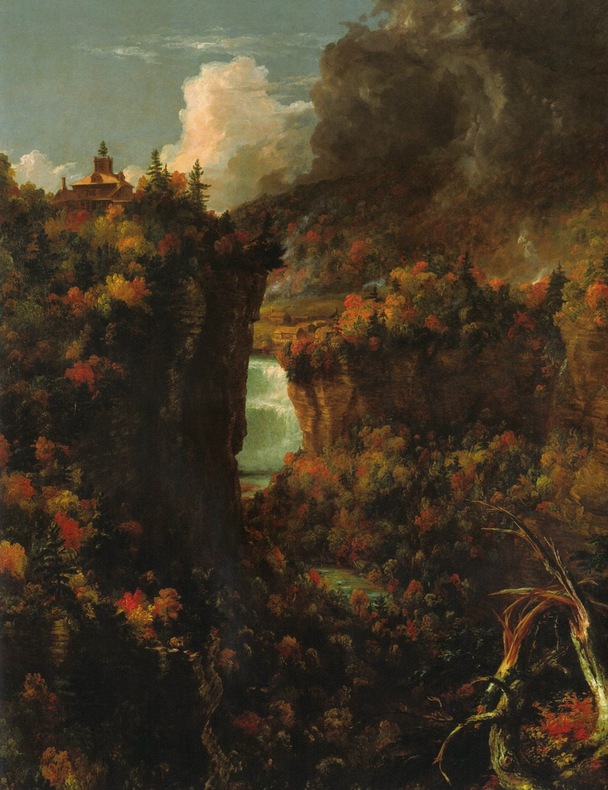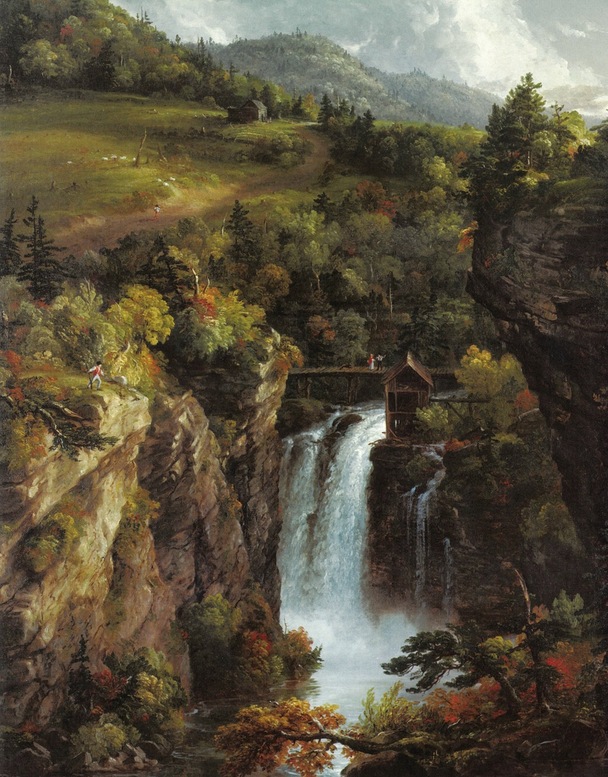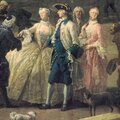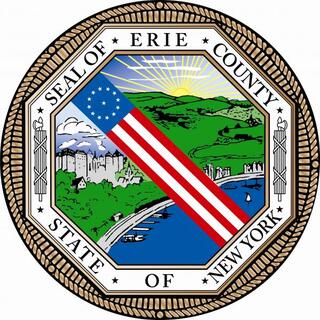
Thomas Cole, Portage Falls on the Genesee, 1841, Collections of Seward House, Auburn, NY.
Photo by Drew Harty
The artist Thomas Cole (1801-1848) was a giant figure of American Romanticism. He is known for his allegorical series including: The Course of Empire, the Voyage of Life and The Architect’s Dream. Cole is considered to be the founder of the Hudson River School of landscape painting. Kindred Spirits, a painting by Cole’s friend and protégé Asher Durand, was a posthumous tribute to Cole. It depicts the painter with the poet William Cullen Bryant conversing on a cliff top in a wild Catskill Mountain scene. (In 2005 the New York Public Library sold the painting for an undisclosed amount believed to be the highest price ever paid for an American painting.)
In his landscapes Cole sought to capture the essence of the American wilderness, in its rugged majesty and sublimity. He visited Western New York several times. The first time was in 1829, when in advance of a trip to Europe to study the great works of the past, he visited Niagara Falls to steel his imagination against the attractions of European culture. He wanted to fire his imagination and memory with the power of the great natural wonder. The painting on our cover, Distant View of Niagara Falls, was the result of that visit. It was painted in London in 1830. The painting is a view of a Native American viewing the panorama, experiencing the sublime.

Thomas Cole, American, 1801-1848, Genesee Scenery, 1847, Oil on canvas, 51 ½” X 31 ¼”, 38.054, Museum of Art, Rhode Island School of Design, Jesse Metcalf Fund.
Photography by Erik Gould
“The sublime” was an important aesthetic concept to Romanticism. As described by the philosopher Immanuel Kant, the sublime was a progressive emotional experience, overwhelming every human faculty, diminishing the ego through a magnitude of force and space. From this assault on the senses, the human mind emerges triumphant and in a spirit of serenity, analogous to the experience of catharsis from tragedy.
Thomas Cole worked from sketches and memory, recollecting his emotions in the spirit of the poet as described by Wordsworth in his Preface to Lyrical Ballads, “the spontaneous overflow of powerful feelings from emotion recollected in tranquility.”
Cole visited another natural wonder of Western New York in 1841. It was to the gorge of the Genesse River that we now know as Letchworth Park. There he was the guest of Elisha Johnson, the engineer brother of Buffalo’s Ebenezer Johnson. On a high cliff above the Middle Falls, Johnson had constructed a rustic architectural wonder called Hornby Lodge. It was in the spirit of what would later be known as an Adirondack lodge. The octagonal log building had a large open central space surrounding the trunk of a giant living oak tree. The tree rose above the roof of the three-story building and a spiral staircase to an outside observation deck surrounded the tree trunk. Thomas Cole made a sketch of the building. For Governor William Seward, the artist made a painting of the gorge and the falls called Portage Falls on the Genesse. It showed the Hornby Lodge and the tree projecting from its center, on the high cliff at the left side of the field of view. The lodge and the top of the cliff were destroyed soon after in the construction of the Genesee Valley Canal. The painting has always hung in the home of William Seward in Auburn, NY.
Another well-know painting by Thomas Cole, called Genesee Scenery, 1847, was painted shortly before Cole’s death. It is in the collection of the Rhode Island School of Design. The large painting depicting a waterfall and a mill is a view seen “from Hornby Lodge.” It was apparently worked up years later from a smaller painting done on site during the 1841 visit. The smaller version is in the collection of the Rochester Memorial Art Gallery.









